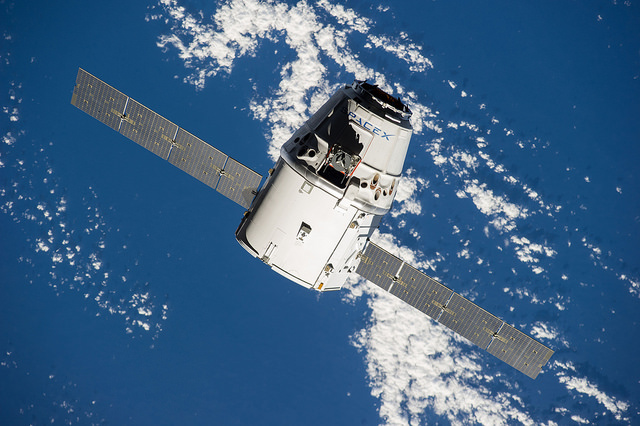
Less than six weeks since its most recent cargo ship returned from the International Space Station (ISS), SpaceX—the Hawthorne, Calif.-based launch services operator, headed by entrepreneur Elon Musk—will deliver another Dragon into orbit on Sunday, 28 June. Liftoff of the CRS-7 mission, which represents the seventh dedicated cargo flight under SpaceX’s $1.6 billion Commercial Resupply Services contract with NASA, is presently scheduled to occur from the storied Space Launch Complex (SLC)-40 at Cape Canaveral Air Force Station, Fla., no sooner than 10:21 a.m. EDT. As with previous ISS-bound Dragon missions, the “launch window” will be an instantaneous one, and an on-time launch will produce a rendezvous and berthing at the space station’s Earth-facing (or “nadir”) Harmony node on Tuesday, 30 June. If SpaceX is unable to meet Sunday’s opening attempt, it carries Eastern Range clearance for a backup opportunity on Monday.
Current predictions for an opening launch attempt on Sunday morning call for mostly cloudy conditions at the Cape, with a 30 percent probability of rain, a 20 percent likelihood of lightning, and temperatures of 32.7 degrees Celsius (91 degrees Fahrenheit). This has produced a current expectation of 90-percent-acceptable conditions for Sunday, with forecasters keeping an eye on a possible violation of the Cumulus Cloud Rule, which is expected to deteriorate to 70 percent favorable by Monday, owing to the added risk of Flight Through Precipitation.
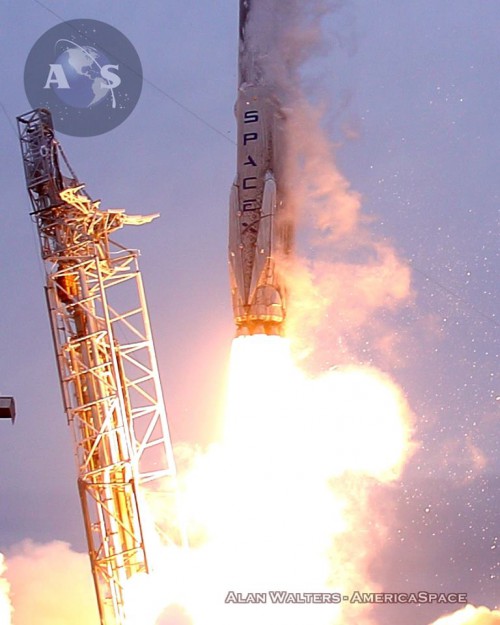
An on-time launch will mark SpaceX’s sixth overall flight of its Falcon 9 v1.1 booster in as many months in 2015, which follows hard on the heels of the CRS-5 and CRS-6 Dragons in January and April, the Deep Space Climate Observatory (DSCOVR) to the L2 Lagrange Point in February, and a pair of commercial missions to loft the Eutelsat 115 West B/ABS-3A dual-payload stack and Turkmenistan’s first national satellite, TurkmenÄlem52E/MonacoSat, both to Geostationary Transfer Orbit (GTO), in March and April respectively. To date, 2015 has proven a spectacular year for SpaceX, with six launches equaling the company’s 2014 achievement and as many as eight others—including the long-awaited maiden voyage of the Falcon Heavy—anticipated before the year ends. The CRS-7 mission will also mark the first occasion that SpaceX has despatched as many as three of its ISS-bound cargo ships in the same calendar year.
As of the time of publishing this story, the Falcon 9 v1.1 booster is expected to conduct its standard Static Test Fire of the nine Merlin 1D engines on its first stage this morning, sometime within a four-hour window. The vehicle will then returned to its processing hangar for final preparations and the standard Launch Readiness Review (LRR), which is presently targeted for Saturday. Due to the nature of its destination, the CRS-7 launch must occur precisely on time. Unlike most other missions, there exists no margin to accommodate last-minute technical issues or poor weather conditions. If the mission cannot launch at 10:21 a.m. EDT Sunday, the attempt will be scrubbed and the countdown clock recycled to track a second opportunity at 9:58 a.m. EDT Monday. AmericaSpace understands that SpaceX’s campaign has been refined to meet such tight windows and that the aim is to roll the Falcon 9 v1.1 out to the pad as close to the launch as possible.
Following rollout to SLC-40, the Falcon 9 v1.1 will be fueled with liquid oxygen and a highly refined form of rocket-grade kerosene, known as “RP-1.” The cryogenic nature of the oxygen—whose liquid state exists within a range from -221.54 degrees Celsius (-368.77 degrees Fahrenheit) to -182.96 degrees Celsius (-297.33 degrees Fahrenheit)—requires the fuel lines of the engines to be chilled, in order to avoid thermally shocking and potentially fracturing them. All propellants should be fully loaded within one hour, and at 10:08 a.m. EDT Sunday, the countdown will reach its final “Go/No-Go” polling point of all stations at T-13 minutes. Assuming it passes through the poll of flight controllers, the Terminal Countdown will get underway at T-10 minutes.
During this phase, the Merlin 1D engines will be chilled, ahead of their ignition sequence. All external power utilities from the Ground Support Equipment (GSE) will be disconnected and at 10:16 a.m., the roughly 90-second process of retracting the “strongback” from the vehicle will get underway. The Flight Termination System (FTS)—which is tasked with destroying the Falcon 9 v1.1 in the event of a major accident during ascent—will be placed onto internal power and armed. By T-2 minutes and 15 seconds, the first stage’s propellant tanks will attain flight pressure. The Merlin 1Ds will be purged with gaseous nitrogen, and, at T-60 seconds, the SLC-40 complex’s “Niagara” deluge system of 53 nozzles will be activated, flooding the pad surface and flame trench with 30,000 gallons (113,500 liters) of water per minute to suppress acoustic energy radiating from the engine exhausts.
At T-3 seconds, the nine Merlins will roar to life, ramping up to a combined thrust of 1.3 million pounds (590,000 kg). Following computer-commanded health checks, the stack will be released from SLC-40 at 10:21 a.m. EDT. Immediately after clearing the tower, the booster will execute a combined pitch, roll, and yaw program maneuver, which is designed to establish it onto the proper flight azimuth to inject the CRS-7 Dragon into low-Earth orbit. Eighty seconds into the uphill climb, the vehicle will exceed the speed of sound and experience a period of maximum aerodynamic duress—colloquially dubbed “Max Q”—on its airframe. At about this time, the Merlin 1D Vacuum engine of the second stage will undergo a chill-down protocol, ahead of its own ignition later in the ascent. At 10:33 a.m., two of the first-stage engines will throttle back, under computer command, in order to reduce the rate of acceleration at the point of Main Engine Cutoff (MECO).
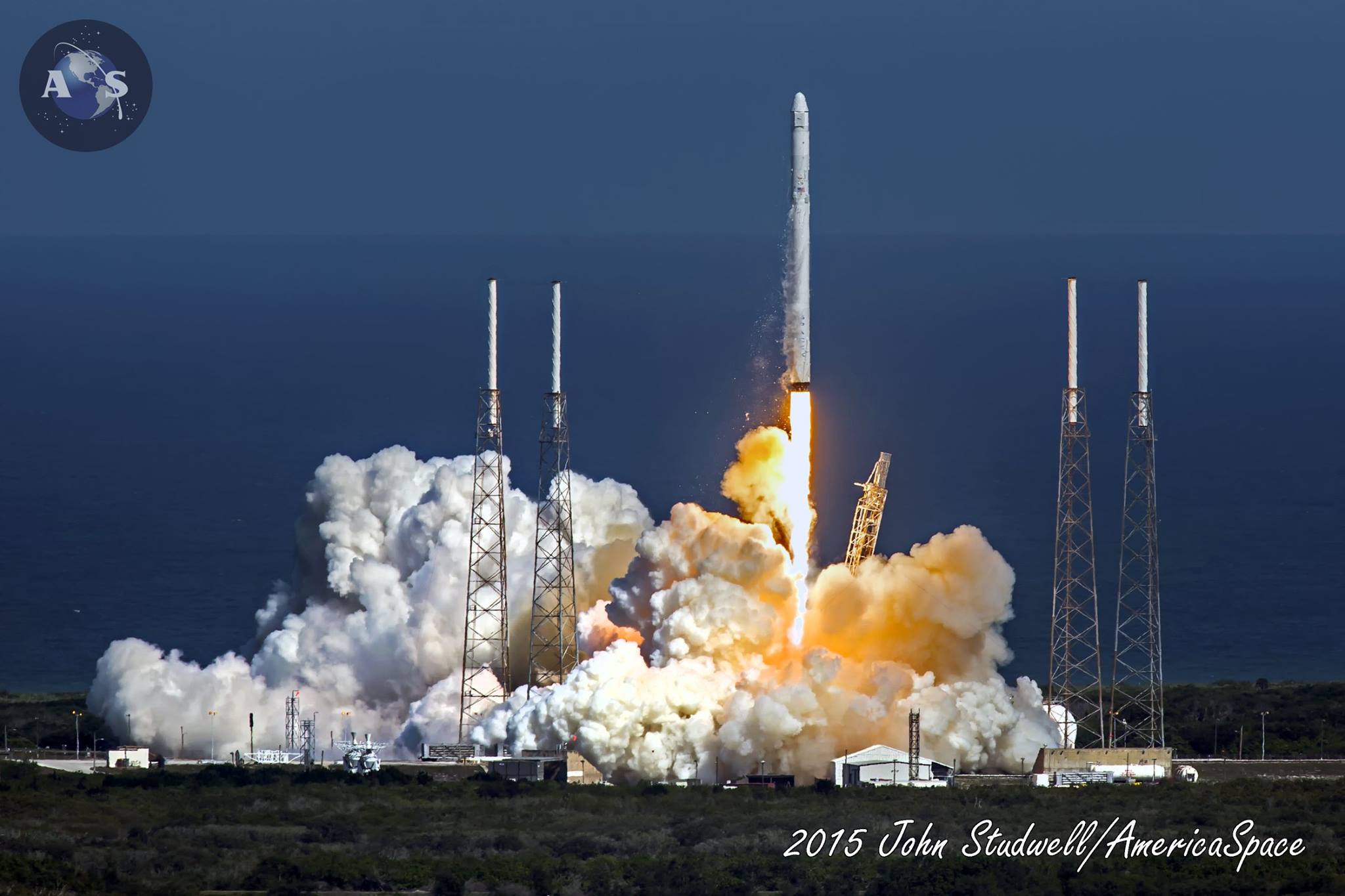
Finally, at T+2 minutes and 58 seconds, the seven remaining engines will shut down and, a few seconds later, the first stage will separate from the rapidly ascending stack. The turn will then come for the restartable second stage, whose Merlin 1D Vacuum engine—with a maximum thrust of 180,000 pounds (81,600 kg)—will come to life to continue the boost into orbit. Based upon previous Dragon missions, it will burn for about six minutes and 45 seconds to inject the cargo ship into a “parking” orbit. During this period, the protective nose fairing, which covers Dragon’s berthing mechanism, will be jettisoned. Ten minutes after departing the Cape, the spacecraft will separate from the second stage and unfurl its two electricity-generating solar arrays, deploy its Guidance and Navigation Control (GNC) Bay Door to expose critical rendezvous sensors, and begin the intricate sequence of maneuvers to reach the ISS on Tuesday, 30 June.
As Dragon begins its journey to the space station, the first stage hardware will begin making its way back to Earth, marking the latest attempt to land it on the Autonomous Spaceport Drone Ship (ASDS) in the Atlantic Ocean, as part of SpaceX’s ongoing reusability effort for the Falcon 9 v1.1. After it separates from the main body of the stack, about three minutes into the flight, the 150-foot-tall (46-meter) first stage will be traveling at a velocity of 2,900 mph (4,670 km/h) and maintaining stabilization has been likened to someone balancing a rubber broomstick on their hand, in the middle of a fierce windstorm. Three Merlin 1D engine firings will be executed in order to steadily reduce this velocity and stabilize the first stage. An initial “Boost-Back” burn will adjust the vehicle’s impact point, pushing it upward and directing it back toward the Cape. Assisted by nitrogen thrusters, the stage will flip over and a “Supersonic Retro-Propulsion” burn will slow it to about 560 mph (900 km/h). A final “Landing” burn will reduce this to just 4.5 mph (7.2 km/h).
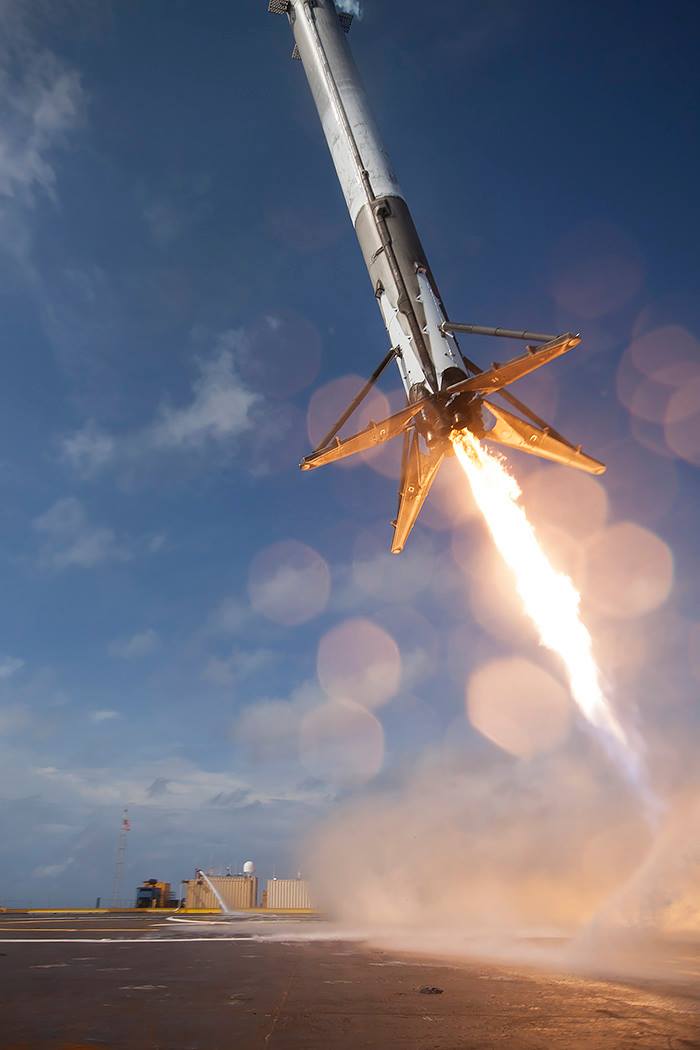
The first stage will utilize compressed helium to deploy its four extendable landing legs and a quartet of lattice-like hypersonic grid fins—configured in an “X-wing” layout—will be unfurled to control the lift vector. Coupled with engine gimbaling, these should enable a precision touchdown on the ASDS surface. An attempt to soft-land first-stage hardware on the ASDS during the CRS-5 launch in January achieved partial success, reaching the deck of the barge, but impacting hard at a 45-degree and exploding, primarily due to a premature exhaustion of hydraulic fluid in its hypersonic grid fins. A second attempt was planned for the DSCOVR launch in February, but was called off due to rough sea conditions, and the most recent attempt during April’s CRS-6 launch reached the deck, but touched down with excessive lateral velocity and toppled over upon impact.
With the Expedition 44 crew of Commander Gennadi Padalka—who, on Sunday, will become the record-holder for the longest cumulative time spent in space by a human being, exceeding fellow cosmonaut Sergei Krikalev’s 803-day career accomplishment—and One-Year crewmen Scott Kelly and Mikhai Kornienko aboard the ISS, this will mark the first occasion that an incoming Dragon has been greeted by only a single U.S. Orbital Segment (USOS) crew member. On all previous arrivals, Dragon berthings at the ISS have been met by at least two USOS astronauts. “Kelly can conduct the grapple and berthing by himself,” NASA’s Rob Navias told AmericaSpace. “Padalka will monitor Dragon’s systems as Kelly’s backup, but will not be involved in the robotics, even though he has some robotics training. Kornienko will tend to Russian Segment systems during the rendezvous.” Assuming an on-time launch on Sunday, Kelly will grapple Dragon at 7 a.m. EDT Tuesday and the cargo ship will be firmly berthed at the Harmony nadir interface by 9 a.m. EDT. In keeping with previous missions, it is expected to remain attached to the space station for about five weeks, with unberthing presently scheduled for 5 August.
According to NASA, Dragon’s pressurized section will be loaded with 4,116 pounds (1,867 kg) of supplies and payloads, including critical materials to directly support over 30 student research experiments and more than 35 of the roughly 250 scientific investigations destined to be performed during the current Expedition 44 and, from September through December, also during Expedition 45, aboard the ISS. “Science payloads will offer new insight to combustion in microgravity, perform the first space-based observations of meteors entering Earth’s atmosphere, continue solving potential crew health risks and make new strides towards being able to grow food in space,” NASA reported. Assuming an on-time berthing, Dragon will remain attached to the station for a little over five weeks, before it is robotically detached by means of Canadarm2 and returned to Earth with about 1,400 pounds (635 kg) of cargo, including crew supplies, hardware and computer resources, scientific experiment results, and trash. Unlike the other unpiloted visitors to the ISS—Russia’s Progress, Orbital Sciences’ Cygnus, Europe’s Automated Transfer Vehicle (ATV) and Japan’s H-II Transfer Vehicle (HTV)—the unique feature of Dragon is that it can survive re-entry intact and bring payloads safely to an oceanic splashdown.
Specifically, CRS-7’s pressurized cargo will consist of 1,490 pounds (676 kg) of crew supplies, care packages from friends and family back home, provisions, and food, as well as 1,016 pounds (461 kg) of vehicle hardware and about 1,166 pounds (529 kg) of scientific equipment for multiple experiments. This will include hardware for the space station’s Environmental Control and Life Support System (ECLSS) and the Electrical Power System (EPS) and investigations sponsored by the U.S. researchers, the Japan Aerospace Exploration Agency (JAXA), and the European Space Agency (ESA). Research foci include JAXA’s Group Combustion investigation to explore fuel-spray dynamics as flames spread across a cloud of gasoline or kerosene droplets and the Meteor Composition Determination study to utilize high-resolution video and imaging to perform the first space-based observations of the chemical constitution of meteors as they enter Earth’s upper atmosphere. Elsewhere, an experiment will collect blood samples from the crew members in order to better understand the shortening of “telomeres”—tiny “caps” on the ends of chromosomes which fray over time, accelerating aging, cardiovascular disease, cancer, and an impaired immune system—in the microgravity environment, whilst the Veg-3 plant-growth investigation will cultivate seeds of lettuce and cabbage and students will contribute to several NanoRack studies into food-crop pollination, radiation-blocking plastics, and solar-liquid power performance. The latter are chiefly sponsored by the Center for the Advancement of Science in Space (CASIS) and are made possible by the station’s role as a U.S. National Laboratory.
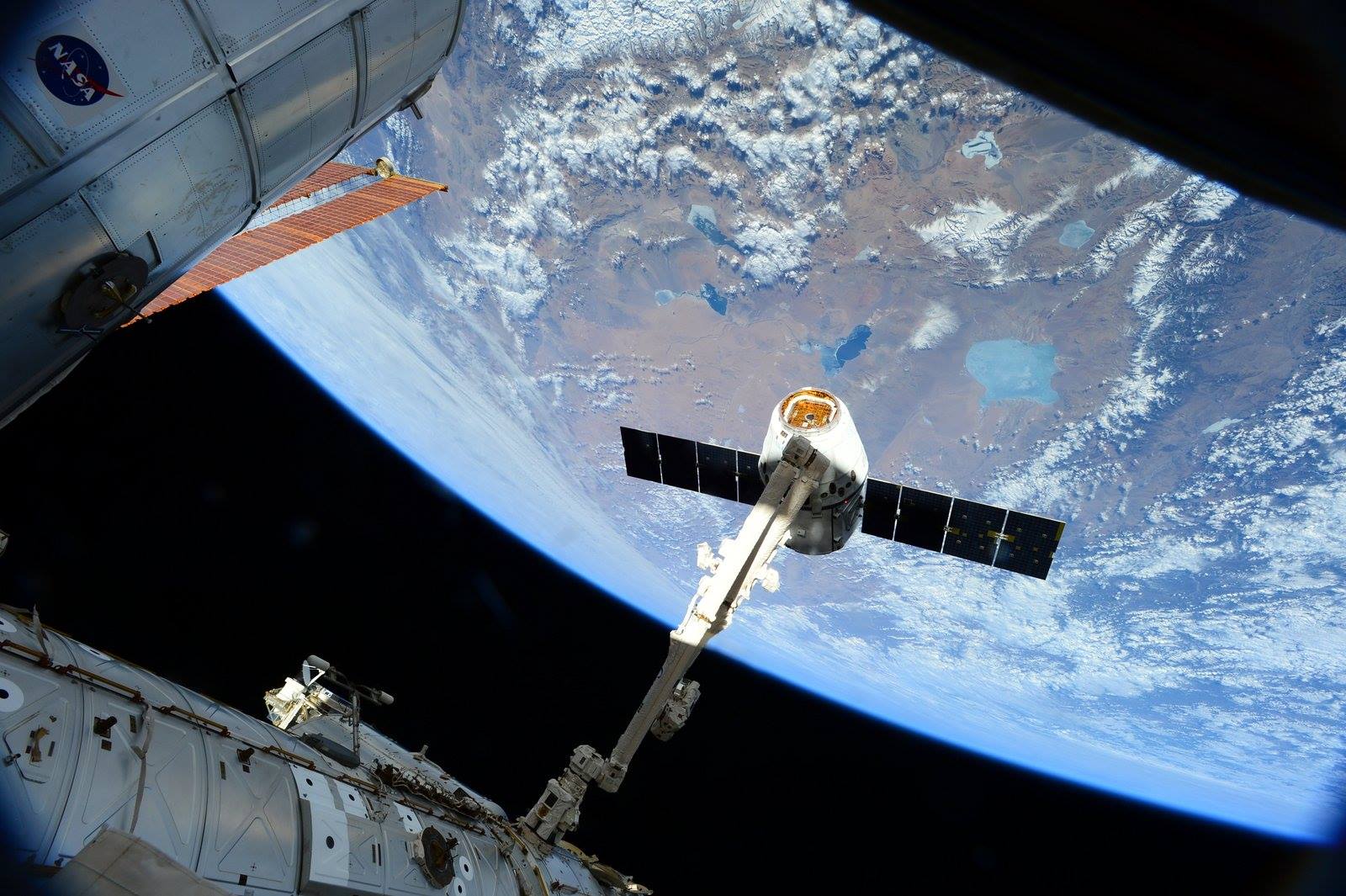
Alongside this pressurized cargo, perhaps the most visible payload aboard CRS-7 is NASA’s first International Docking Adapter (IDA-1), which will be installed onto the Pressurized Mating Adapter (PMA)-2 interface, at the forward end of the Harmony node, during EVA-32 in the July-August timeframe to prepare the U.S. Orbital Segment (USOS) for its future Commercial Crew needs. As described in a recent AmericaSpace article, the 1,150-pound (520-kg) IDA-1 was delivered from Boeing’s Houston Product Support Center (HPSC) to the Kennedy Space Center (KSC) in Florida in February 2015 and the paperwork was officially signed on 11 May, transferring responsibility for the payload from NASA to SpaceX.
IDA-1 consists of a squat cylinder, measuring about 30 inches (76.2 cm) in height. Boeing served as Lead Integration Contractor, but products for IDA-1 and its identical twin, IDA-2—which is due to fly aboard the CRS-9 Dragon in December 2015—the docking adapters have been drawn from around 25 U.S. states. IDA-1 is fully compliant with the International Docking System Standard (IDSS). This effort by the ISS Multilateral Co-ordination Board sought to create an international docking standard for the USOS, which presently consists of U.S., European, Japanese, and Canadian modules and other hardware assets. In conference notes from Headquarters in Washington, D.C., in April 2011, NASA rationalized the need for this standard. “Connecting spacecraft from different nations has required unique development and expensive integration and test,” it was explained. “Expansion of spacefaring nations (and non-governmental entities) will compound this issue in the future. Exploration co-operation could be much easier with internationally accepted interface standards.” As well as having a firm heritage in flight-proven designs, the IDSS also incorporates low-impact technology, which “accommodates a wide range of vehicle contact and capture conditions.”
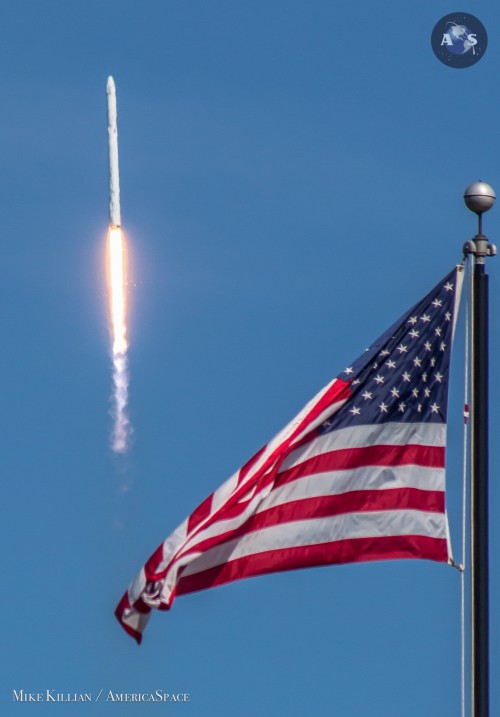
“The International Docking Adapter is actually the first implementation of our International Docking System Standard,” explained Sean Kelly, NASA’s Senior Project Manager for Relocation & IDA, speaking in February 2015. “We’ve developed that over the last few years with all of our International Partners, so it’s really the first standard that we have in the spaceflight business and, as such, we wanted to lead the way and NASA established an effort to develop the International Docking Adapter. We tried to put the emphasis on ‘international’, because although it’s in the critical path for Commercial Crew, it’s also a key element for what we plan for other international partners to come visit Space Station and start utilizing it in the future.”
IDA-1 will travel into orbit suspended “under” Dragon, in its trunk, with circumferential trunnion pins providing secure attachment for the journey uphill. The installation of IDA-1 onto the PMA-2 interface at the extreme forward end of the Harmony node requires a combined robotics and spacewalking operation. Originally, this spacewalk—designated “U.S. EVA-32”—would have been performed in July, involving Expedition 44 astronauts Scott Kelly and Kjell Lindgren, supported by JAXA’s Kimiya Yui. With the arrival of Lindgren and Yui at the ISS aboard Soyuz TMA-17M now delayed until 22-23 July, EVA-32 will be correspondingly postponed. Moreover, since Dragon’s nominal stay-time at the ISS is about five weeks, AmericaSpace understands that IDA-1 will be robotically removed from the trunk by the Robotics Officer (ROBO) in the Mission Control Center (MCC) at the Johnson Space Center (JSC) in Houston, Texas, by means of the 57.7-foot-long (17.6-meter) Canadarm2 robotic arm. According to NASA’s Rob Navias, it will then be “temp-stowed” on Canadarm2’s Dextre Special Purpose Dextrous Manipulator (SPDM), where it will await the combined EVA-32/robotics operation to install it onto its permanent location at the PMA-2 docking interface.
When the team is ready to execute the installation, shortly after the arrival of Lindgren and Yui, IDA-1 will be positioned by the Canadarm2/Dextre between 10 inches (25 cm) and 2 feet (60 cm) from the forward end of PMA-2. Performing EVA-32, Kelly (EV1) and Lindgren (EV2) will then attach tether straps to IDA-1, whereupon it will be released by the ISS robotics and manually maneuvered into position by the spacewalkers. External connectors and internal switches and driven hook-motors will be closed to permit full integration. Like other ISS components, IDA-1 carries EVA handrails around its circumference and at its base is a sealing surface to interface with PMA-2, together with a trio of “guide petals” and mechanical latches for accurate installation.
“These latches will strike over to the IDA on their striker plates and that’s how the attachment of the visiting vehicle to the IDA will happen,” said Mr. Kelly. “That normally happens with the Soft Capture system extended and then that Soft Capture system retracts, thereby making the two halves of the docking system go together and mate. That creates a pressurized seal and a structural seal between the two of them.”After a visiting vehicle has docked, power and data exchange will occur automatically. “But there’s also air exchange that has to happen,” continued Mr. Kelly. “They [the crew] have to put in some duct work and that’s to allow air exchange between the Visiting Vehicle and the space station, once it’s docked.” The crew will also remove a rendezvous target, used during the docking process, in order to achieve a smooth ingress into the ISS. Current plans envisage the first piloted voyages by SpaceX’s Dragon V-2 and Boeing’s CST-100 to take place in mid-2017. The installation of IDA-1 will effectively convert the PMA-2 docking interface from its original Androgynous Peripheral Attach System (APAS)-95 specification to Boeing’s new Soft Impact Mating and Attenuation Concept (SIMAC), which NASA accepted in late 2012 to satisfy its Commercial Crew requirements and replace earlier plans for an international Low Impact Docking System (iLIDS) soft-capture mechanism. IDA-1 will then become the primary interface for Commercial Crew vehicles, with IDA-2 providing a backup.
Be sure to “Like” AmericaSpace on Facebook and follow us on Twitter: @AmericaSpace




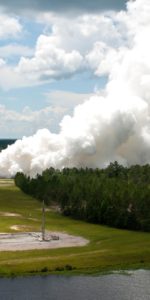
Good write-up Ben. Taking up the IDA-1 somehow feels like a watershed event, things are getting real.
As always, thanks to AmericaSpace team for all those beautiful high-def images.